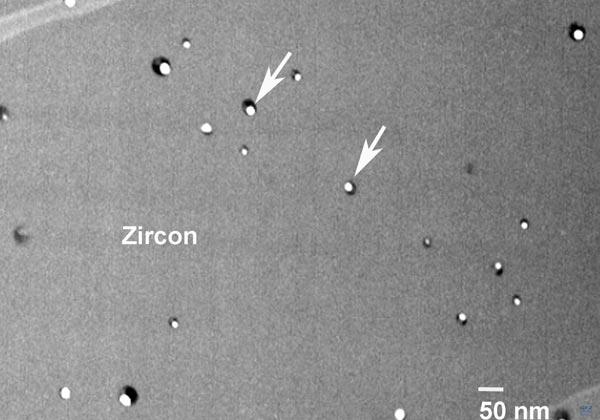Lead hokes the Age

Zircon from East Antarctica with nanospheres of metallic lead under GFZ’s transmissionelectron-microscope TEM. The rock sample is more than 3,4 billion years old. Photo: GFZ
Rocks do not loose their memory during Earth history but their true ages might be distorted: even under ultra high-temperature metamorphic conditions exceeding 1200°C zircon maintains its lead content accumulated during radioactive decay of uranium and thorium.
Giga year old zircon crystals still contain lead in form of nanometre size spheres of pure lead. However, the inhomogeneous spatial distribution of the lead spheres might falsify ages determined from high-resolution Pb isotope measurement with ion probe.
Zircon is an ideal mineral for age determination of very old rocks because it is believed to be a closed system during Earth history.
Zircon geochronology thus is a standard method of geological age determination. Recently, an international group of earth scientists studied zircon from 3,4 billion years old high-temperature metamorphic rocks from Antarctica with transmission electron microscopy TEM at the GFZ German Research Centre for Geosciences.
TEM investigations revealed that the lead from radioactive decay was not homogeneously distributed in zircon but was accumulated withinin inhomogeneously distributed Pb nano-spheres in zircon with only 5 to 30 nm in diameter.
The inhomogeneous distribution of lead in zircon might adulterate the ages measured with high-spatial resolution ion probe technique.
Monika A. Kusiak et al.: “Metallic lead nanospheres discovered in ancient zircons”, Proceedings of the National Academy of Sciences, PNAS Early Edition, 06.04.2015, DOI: doi/10.1073/pnas.1415264112
Media Contact
More Information:
http://www.gfz-potsdam.de/All latest news from the category: Earth Sciences
Earth Sciences (also referred to as Geosciences), which deals with basic issues surrounding our planet, plays a vital role in the area of energy and raw materials supply.
Earth Sciences comprises subjects such as geology, geography, geological informatics, paleontology, mineralogy, petrography, crystallography, geophysics, geodesy, glaciology, cartography, photogrammetry, meteorology and seismology, early-warning systems, earthquake research and polar research.
Newest articles

Combatting disruptive ‘noise’ in quantum communication
In a significant milestone for quantum communication technology, an experiment has demonstrated how networks can be leveraged to combat disruptive ‘noise’ in quantum communications. The international effort led by researchers…

Stretchable quantum dot display
Intrinsically stretchable quantum dot-based light-emitting diodes achieved record-breaking performance. A team of South Korean scientists led by Professor KIM Dae-Hyeong of the Center for Nanoparticle Research within the Institute for…

Internet can achieve quantum speed with light saved as sound
Researchers at the University of Copenhagen’s Niels Bohr Institute have developed a new way to create quantum memory: A small drum can store data sent with light in its sonic…




















